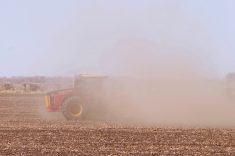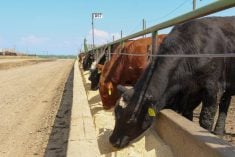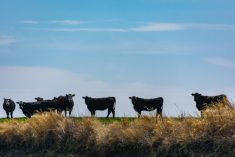A woman we’ll call Teresa, who farms two sections of grain in southeastern Manitoba, is 63. She works through a farm corporation worth $1.4 million and has personal farmland worth $1.75 million.
The breakdown: she has non-farm assets of $419,000, savings of $400,000 plus a TFSA with assets of $100,000, and other savings of $800,000. Her annual retirement needs at 65 will be $60,000.
Teresa inherited her parents’ farm five years ago. She wonders how to manage her taxes efficiently and pay herself an adequate retirement income. Her farm, in southeastern Manitoba, is financially productive. Her problem: retaining value and generating income in her retirement. Teresa has sufficient assets to pay herself an income of $5,000 per month for the rest of her life.
Read Also

Gentle treatments for pain in the neck
Heading toward year-end, people unknowingly tense up against the cold and busyness, causing neck pain that can often be treated with appropriate support and gentle mobility, athletic therapist Kathlyn Hossack says.
The question is, what’s the best way to generate this income? According to Colin Sabourin, a senior advisor and certified financial planner with TransCanada Wealth Management in Winnipeg, the solution requires both tax and investment management.
Colin notes that Teresa currently receives all the farmland net rental income. That rental revenue, both corporate and personal, of $55,000 flows through the corporation. She isn’t being taxed personally on the rental income from the personal farmland due to this.
She’s currently withdrawing $5,000 each month from a joint savings account she has with her husband. This leads to an average of $5,000 per year in capital gains being triggered. Between her current savings and joint savings, she’s having to declare approximately $35,000 of annual interest income. The corporation is also paying her a wage of $10,000 a year.
In total, her taxable annual income is currently around $47,500. She isn’t taking CPP (Canada Pension Plan) or withdrawing from her RRSPs (registered retirement savings plans) yet.
Teresa is sitting on quite a few assets. Sabourin recommends she work to increase her taxable income to $79,626, as in Manitoba, that’s where the combined federal tax bracket goes from 33.25 per cent to 37.9 per cent. Any taxable income earned above $79,626 gets taxed at the 37.9 per cent rate. It makes sense to maximize Teresa’s lower brackets and take advantage of the lower tax rates.
The plan
Start having the personal farm rental income taxed personally. Currently the income from her personal farmland is being taxed corporately. Since rental income is considered passive income and not active income, it’s being taxed close to 50 per cent. By moving this income to her personally, she’ll only be paying tax at the 33.25 per cent rate.
Then, increase her wage from the corporation. Teresa is short by $3,126 to maximize her tax brackets, so she should increase her salary by this amount, to increase her taxable income to $79,626 for the year, Sabourin recommends.
Tax planning in the future
Teresa is currently not receiving CPP or OAS (Old Age Security), nor making any withdrawals from her RRSPs. This is all income that’s going to start being added to her income in the future. She can choose to start CPP at any point between now and 70 years old; OAS, 65-70; and her RRSPs need to be converted to a RRIF (registered retirement income fund) by 71, with her first withdrawal being forced at age 72.
Teresa will need to be aware of the OAS clawback which currently starts at $86,912 for the 2023 tax year. The clawback will increase with inflation, so we assume a 3.5 per cent inflation rate over the next two years; the clawback will be around $93,100 by the time she turns 65 years old. Every $1 you make above the OAS clawback threshold, you need to repay 15 cents of your OAS, so it’s quite a high tax cost.
If Teresa starts to take CPP and OAS at age 65, this will add an additional $20,000 to her income. If we combine this new income with my recommendation of increasing her income to $79,626, she’ll be way over the OAS clawback threshold.
Recommendations
- Consider deferring when she starts her OAS and CPP. The longer Teresa waits, the higher the OAS clawback will climb due to inflation. However, how much she receives from CPP and OAS will also be increasing, as you get a bonus by deferring it, so this strategy wouldn’t completely avoid OAS clawback. Furthermore, the question of deferring CPP and OAS always comes back to: what’s your life expectancy? It doesn’t make sense to defer if you believe you won’t live well into your 80s. In Teresa’s case, she has longevity in her family, therefore I’d be comfortable recommending she defers it.
- Consider changing how her investments are positioned. Currently, she is generating interest income. She’s forced to claim this income every single year and it’s 100 per cent taxable. Assuming she’s comfortable with buying stocks, her annual taxable income would be reduced because her stocks would be generating dividends and presumably capital gains, both of which are taxed less than interest income. By reducing her interest income and converting it to dividends and capital gains, she’ll lower her taxable income under the OAS threshold.
Once Teresa is forced to start making withdrawals from her RRIF, it’ll be harder to keep her income under the OAS clawback. Currently, if you’re 72 years old, you’re forced to withdraw 5.4 per cent of your RRIF annually, with this figure increasing every year. Assuming Teresa’s RRSP grows at a rate of five per cent over the next nine years, her minimum withdrawal at age 72 will be approximately $21,000.
Based on Teresa having a higher income in the future, it’s even more imperative that she takes advantage of her lower tax brackets while she can. The more taxable income she declares today at lower rates, the less she’ll have to declare at higher rates in the future.















